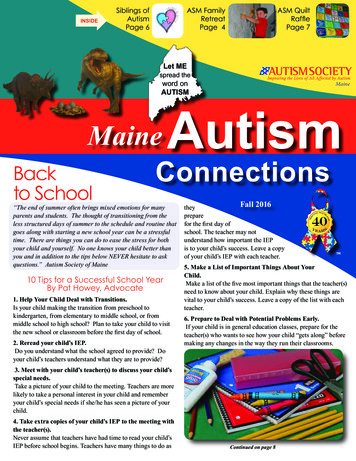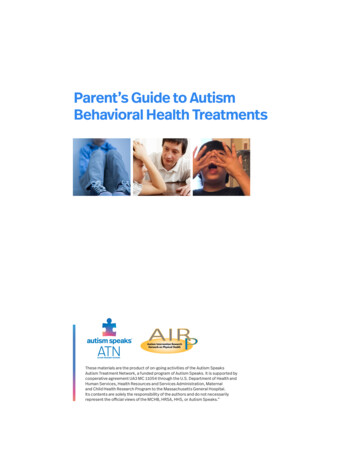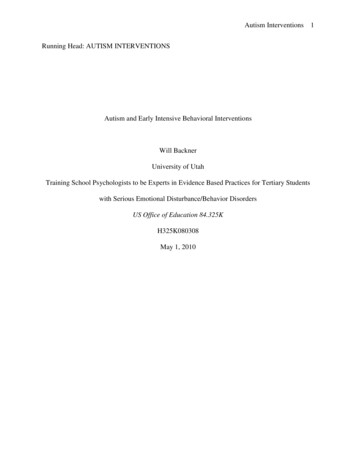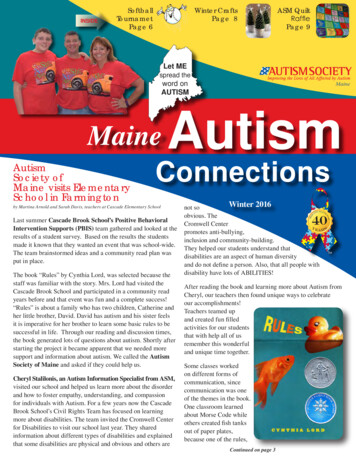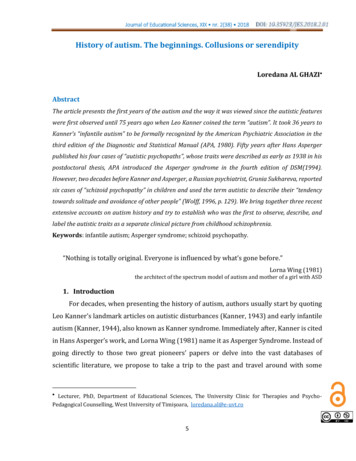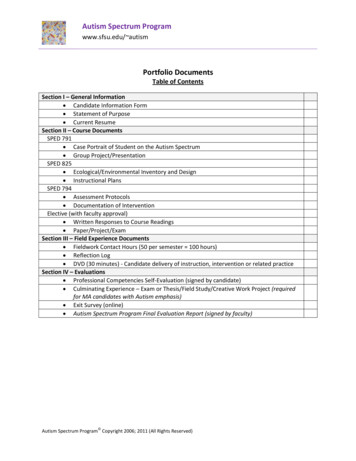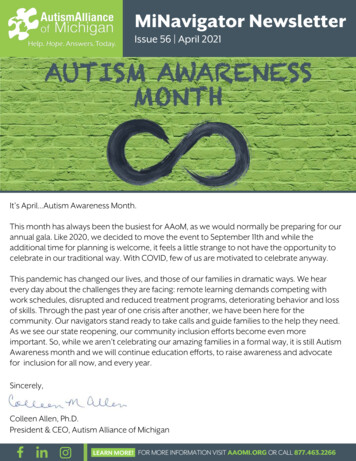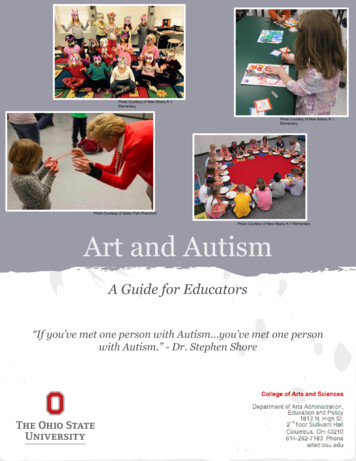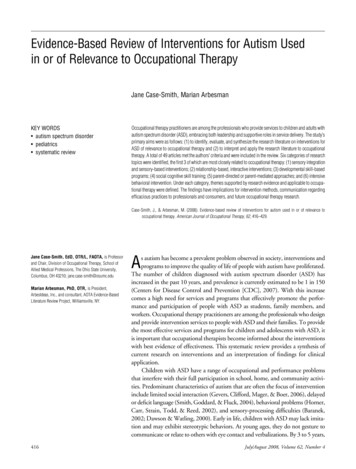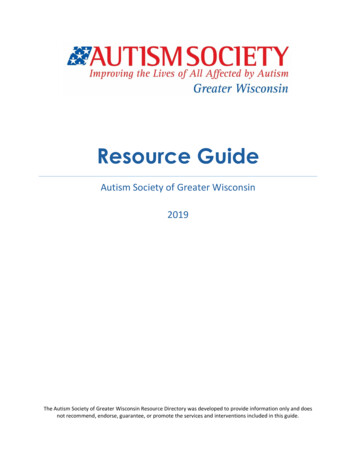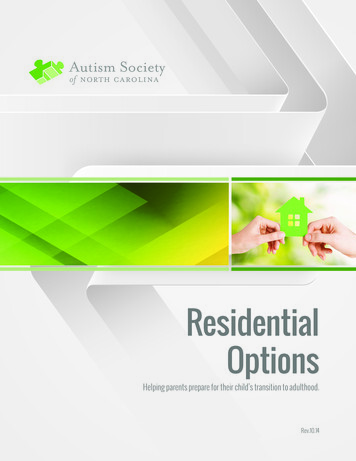
Transcription
ResidentialOptionsHelping parents prepare for their child’s transition to adulthood.Rev.10.14
About the toolkitThis toolkit is for parents and guardians of children and adults on the autism spectrum. It is designed to helpparents as they begin to prepare for their child’s transition to adulthood by exploring the emotional aspects ofplanning for their child’s future, learning about the options available on a continuum from independent living togroup living settings, and learning how to begin planning for their child’s future residential options.Table of contentsThis toolkit is broken into different sections; you can read all of it or just choose sections that mostinterest you.Plan for your loved one’s future. 3How are you feeling?Initial questions to considerTypes of residential supportsPreparing for independent living. 6Group living. 7Get a list of facilitiesTour the facilitiesQuestions to askAdditional Resources. 10Glossary. 11Appendix: The Young Men of Marram Place. 12Beyond the toolkitIf this toolkit raises new questions for you and you want to talk with someone about planning for your child’sfuture, ASNC can help. In every NC county, ASNC has Autism Resource Specialists who are experienced parentsof children with autism and trained autism educators and advocates. You can find contact information for theAutism Resource Specialist in your community here: http://bit.ly/AutismResourceSpecialists. ASNC also offersseveral workshops that might be helpful on topics such as guardianship, transitioning to adulthood, and residentialoptions; check the workshop schedule to see whether one is upcoming, http://bit.ly/ASNCWorkshopCalendar, orask your Autism Resource Specialist.If you would like to read more, please refer to the end of the toolkit for additional information sources that arerecommended by the ASNC Advocacy and Bookstore staff. To keep updated on the latest books and DVDs, weinvite you to connect with the ASNC Bookstore on Facebook, at https://www.facebook.com/AutismBookstore, orby emailing staff at books@autismsociety-nc.org to tell them you would like to join the newsletter mailing list.ASNC has about 50 local chapters and support groups across North Carolina, and they can be an excellent place toconnect with other parents, gain encouragement, and learn from their experiences. Chapters are parent-run andoffer support and education on a wide variety of topics, including residential options. To find one near you, pleasego to our website: http://bit.ly/ASNCChapters.Pg 2: Residential Options Toolkit
Plan for your loved one’s futureHow are you feeling?Time moves all too fast. It can feel as if you just got the diagnosis, and then the next thing you know, your childwith autism is an adult. When your child is young, time can almost seem to stand still. You are so consumedwith the day-to-day aspects of getting through life: school issues, therapy appointments, doctor visits, moretherapy, etc. The day to day can seem overwhelming, leaving you little time for planning. Then when your childdoes become an adult, it can be difficult to view him or her that way. It is even more difficult emotionally toacknowledge that you as a parent will not be around forever to help your child. The future gives us one guarantee:that it will be upon us whether or not we plan for it. This can leave us with many questions. What will happen tomy child when he/she becomes an adult? Where will my child live? What will he/she do? How can I be sure my childis safe and well cared for? These questions lead to many emotions that we must deal with: Fear: Will he/she be safe without me? Denial: Can I really allow him/her to move out and live away from me? Guilt: If I let him/her live somewhere other than home, what will people think of me? Inadequacy: If only I had tried harder. Protectiveness: No one will take care of my loved one like I do. Sadness: What will I do without him/her here with me each day?What can we do to overcome all of these feelings as parents? One of the best thingswe can do is to have a plan. Many people look to their close relatives, such as siblings,aunts, or uncles, as options for when they are no longer around. This can be a choicefor some families, but not everyone has that option. Even if you have an identifiedperson to help support your loved one when you are gone, you still need to do a greatdeal of planning (financial, medical directives, end-of-life planning) to make sure thatperson carries out your wishes for your child. You will also need to think about whereyou would want your child to live. How will you pay for their living situation? A specialneeds trust, Social Security Disability, their own income?Initial steps: What are my child’sstrengths and needs? How much care/supportdoes my child need on adaily basis? Make a decision based onyour answers and thenmake a plan to get there. Initial questions to considerIf you have not already done so, this is a good time to sit down and realistically think about your child’s strengthsand needs. When at all possible, try to involve your loved one in the planning. After all, it is their life, and everyperson deserves to be independent to the extent that is possible for him/her. What can he/she do independently? What is your child good at doing? What are his/her likes and dislikes? Would your child enjoy a quiet countrysetting or a city life with lots to do? If your loved one can work, how much?What type of work would your child enjoy?If you have one, a care coordinator can also be helpful in deciding what types of support your child needs.Think about assessment tools such as the Support Intensity Scale (SIS) or Special Needs Assessment Profile(NC-SNAP) levels that are often used to determine level of need for individuals with disabilities. (To see theNC-SNAP, go online to sidential Options Toolkit Pg 3
{Plan for your loved one’s future continued} Does your child need full-time care with 24hour supervision or can he/she live a moreindependent life with check-in supports? Does the individual need to participate in avocational supported employment program or astructured day program setting? Does he/she have medical or behavioral needsthat require more supervision? If the individual works, what type oftransportation will be provided or available? Can the individual live with others or does he/sheneed a private setting or private room?Once you have determined what would be the optimal living option, set about to develop a plan to get there. I f your child is going to live independently or semi-independently with supports, what are the life skills they willneed to make that a reality? Think of cooking, cleaning, taking medications correctly, paying bills, and dailyhygiene. If your child wishes to live semi-independently, does he/she have funds available to pay for rent, utilities, food,and other essentials? If not, check with your managed-care organization (MCO) and local Department of SocialServices about funding sources such as the NC Innovations Waiver, Medicaid, Social Security Disability Insurance(SSDI), or Supplemental Security Income (SSI). What would be the funding stream for your child if he/she is going to live in a group setting? You will need toconnect with your MCO to learn more about facility options. Wait lists can be long, so don’t wait.Whether you want your child with Autism Spectrum Disorder (ASD) to live independently with limited supports orin a more structured supervised setting, it is never too soon to begin planning.Types of residential supportsGroup livingIntermediate Care Facility for Individuals with Developmental Disabilities (ICF/IDD): This type of setting wouldbe geared toward a person diagnosed with a developmental disability who has a high level of need and wouldneed staff present 24 hours per day to assure safety and to provide habilitative care and training. They provide24/7 staff levels that meet the needs of the individual and a multi-disciplinary team of professionals is available forconsultation and support to the individual and staff. In addition to personal care and habilitative supports, an ICFmust provide specialized therapies as needed and an active treatment plan at all times. ICFs must follow state andfederal guidelines. They are of varying sizes, but most have six individuals living in this type of setting. With thisoption, the funding stream is Medicaid and the funding stays within the home, not with the individual. Individualswho have Innovations Waiver services can become eligible for services in an ICF/IDD setting but would lose theirInnovations Waiver funding if they are admitted to this type of setting.Homes for Developmentally Disabled Adults (DDA): This type of setting would be geared toward a persondiagnosed with a developmental disability who has a low to moderate level of need and would not necessarilyrequire awake staff at night. There is still a high staff-to-consumer ratio to help maintain safety and to providetraining to learn new skills. An individual in this type of setting would need limited assistance to build skills in avariety of areas and often must be able to do most self-help activities independently or with just an occasionalreminder. Again, state guidelines call for new facilities of this type to house no more than three individuals, butolder facilities already in operation may house as many as six. With this setting, the funding stream stays with theindividual and might include Medicaid, Innovations Waiver, SSI, and/or SA.Alternative Family Living (AFL): This type of setting would be geared toward a person diagnosed with adevelopmental disability who has a lower to moderate level of need. The staff working in these settings actuallyPg 4: Residential Options Toolkit
{Plan for your loved one’s future continued}live in the home as their own residence and provide habilitative services as a provider under the supervision of thelocal MCO. AFLs are more ideal settings for individuals who would prefer not to live within a larger group homesetting and would benefit from living in a more family-oriented setting. Individuals residing in an AFL settingmust need a low staff-to-consumer ratio and must need limited assistance to build skills across a variety of areas.Individuals who reside in an AFL setting typically attend a local school or day program or have a job during mostof the day. With this setting, the funding stream stays with the individual and might include Medicaid, InnovationsWaiver, and/or SSI.Unique living arrangementUnfortunately, many parents of children with autism are finding group living options to be limited and oftenquite scarce. Some parents have been choosing to “think outside the box” and create their own unique livingarrangement to meet their child’s needs. How do they do this? Basically, they combine resources, purchase a home,and hire a provider to provide needed services for their children. (To read about one such arrangement, pleasesee the appendix to this toolkit, “The Young Men of Marram Place.”) The parents can work together to get thehome licensed through state and local requirement just as any provider goes through licensing requirements. Theparents might hold the mortgage, becoming essentially the “landlords” for the home with their children payingrent using a combination of monies from a job and/or their funding stream such as Innovations Waiver services,SSI, or SA. The parents might work at fundraising to help with financial sustainability of the home, and they mustwork with an attorney specializing in special needs estate planning to help ensure that the home will be sustainedfor their loved ones when they are no longer around. If using waiver funds, the provider would be responsible forcompliance with MCO regulations regarding service delivery, staffing, record keeping, billing, and needed trainingfor staff. The provider would do all of the hiring of staff as well as training and payroll. Some providers are willing tohelp families create their own residential options. Remember all residential options must have a funding source, soif your child already has a funding stream for services such as Innovations Waiver or SSI, you may be able to get theprovider to be more creative in regards to living options. For example, an adult could live in an apartment settingor house with supports paid for via Medicaid, Innovations Waiver, SSI, or SA funding.Independent or semi-independent livingMany individuals with ASD may need very little support to live completely on their own or with limited supports.This can be a little daunting for many parents to consider, especially when they begin to think ahead to the futurewhen they may not be present to provide support. However, there are resources that could be used to enable moreindividuals with autism and/or other developmental disabilities to live independently or semi-independently. Someof the services include customized living systems, security equipment, environmental controls, video monitoring,and other various sensors and modes of communication. These would help in monitoring daily patterns of livingand could proactively alert caregivers of changes in behavioral patterns and possible need for assistance. Someagencies also provide monitoring by trained call staff on a 24/7/365 basis to ensure that an individual living alonehas support as needed. Other factors to consider are transportation, options for leisure time, and distance tonatural supports such as grocery stores and banks. Funding streams for independent living options may includeincome from a part- or full-time job, Innovations Waiver services, SSI, Medicaid, SA, and Key Program Assistance.Many adults with long-term disabilities are eligible for support within a framework of low-income housing such asapartments specially designed for people with disabilities.DHHS-managed funds are subject to approval under the federal Home and Community-Based Services regulations,which ensure choice and access and encourage freedom and integration in congregate settings. (For more information,see y-based-services.html.)Residential Options Toolkit Pg 5
Preparing for independent livingAs your child approaches adulthood, it is important for him/her to learn independent living skills and selfadvocacy. Start these lessons early and keep them going on a daily basis. Begin by observing your child. Removeyourself from the equation and consider how your child would function without you there. Think about his/herhygiene, grooming, and behavior. How would your child react in an emergency? Can he/she prepare a snack ormeal for himself? Can your child choose appropriate clothing for the weather or event?You can teach these skills to your child over time, and now is the best time to begin. Start with basic skills, suchas making a meal – even a sandwich – and doing laundry. Use schedules, breaking tasks down into smallerpieces. Below is a list of skills you may want to help your child master before it is time for him/her to leave yourhome.Ask yourself whether your child can Grooming/dressing Prepare for a special outing Dress/undress self Arrange special activities Identify things that requireprofessional to fix Choose appropriate attire foroccasion, weatherTime managementMoney/shopping Comb/style hair Plan homework timeHygiene/health Plan time for chores Make time to study Handle money exchanges Make a budget Understand budgetaryconstraints Use private and publicbathrooms Arrange transportation Wash handsSocial skills A sk for help in a store Bathe without assistance Use a telephone Manage menstrual care Practice proper telephoneetiquette Make choices with costcomparison Shave Use deodorant Brush teeth Floss, use mouthwash Treat a cold or other minor illness Follow a list in a grocery store Withdraw cash from an ATM Take, relay a phone message Write a check Arrange a leisure activity Pay bills on time Give giftsRestaurants Remember birthdays Read menu (or alternative) Call a doctor Send thank-you cards Manage medication – taking it asdirected and getting refillsHousehold chores Use manners Keep living spaces neat Tally bill with tip Make bed, change bed linensLeisure time Manage medical appointments Communicate with serverPlanning/scheduling Do laundry Tell time Plan, purchase, and cook meals Follow daily routines Operate appliances Navigate an airport or train orbus station Show up on time, in the rightlocation Arrange for trash collection andutilities Use public transportation Adapt to change in routine Plunge a toilet Make travel arrangements Navigate a new place whenvisitingPerhaps most importantly, does your child know when and how to ask for help? Make sure he or she knows to callyou when in doubt. Use the old clichés: “There’s no such thing as a stupid question,” and “It never hurts to ask!”Pg 6: Residential Options Toolkit
Group livingGet a list of facilitiesBecause of the various and frequent changes in service definitions and deliveryfor individuals with disabilities in North Carolina over the past several years, it isdifficult to create a complete list of all specific facilities that might be an option.To get the most comprehensive and up-to-date listing of options, parentsshould contact their local MCO. (If you are not sure how to connect with yourMCO, go to this link http://www.ncdhhs.gov/mhddsas/lmeonblue.htm to findwhich MCO serves your county of residence.)Let the MCO know you are searching for residential supports. All residentialsupports need a funding source such as Medicaid, Innovations Waiver, SSI, orSpecial Assistance (SA). If you do not have a care coordinator or communityguide, ask the MCO to connect you with one for help in navigating this process.Another source for a list of residential providers is the Division of FacilityServices website at http://www.ncdhhs.gov/dhsr/reports.htm. You can checkto see whether a licensed facility has any violations listed at the following lties.htmlTour the facilitiesIf you’re interested in a provider, ask to tour the facility. Many will allow youto tour even if they don’t currently have an opening. It is a good idea to visitseveral homes/facilities while you’re NOT under pressure to pick one. If you areinterested, fill out an application and put it on file. Even if you’re not quite readyto take that step, it’s best to get applications in early, because wait lists canbe very long. Remember, if an opening does occur and you are not ready, youcan always decline it. It is also helpful to take along a family member or friendwho can be objective. When at all possible, seek input from your child on thespectrum on what his/her desires and needs are in a residential option.Wait lists can be verylong for group homes;do not wait to researchfacilities.As you are choosing,here are some areas toconsider: How the facility is run andoverseen Training and quality ofstaff Quality of life yourchild will have as far asactivities, home visits,outings, etc. Rules and regulations ofthe facility Relationships betweenfamilies and facility staffVisits to the homes are akey part of your research.continued on next pageResidential Options Toolkit Pg 7
{Group living continued}Questions to askBefore your visit, you may want to call the facility and find out some background information: How long has the agency been in business? Look forfinancial stability. Is there an organized parent group within theagency? What is the accreditation level of the group home? A sk a manager to tell you the group home’s successstories. Consider the location of the home and overallsupervision, as far as safety goes. Consider the home’s distance from your residence. Are guardians encouraged to give input andparticipate in planning? Is there open communication between the staff andfamily or does all communication go through thegroup home manager? A sk the manager what the home does well and whatcould be improved. If the group home is a nonprofit with a board ofdirectors, are there parents on the board? Arepeople with disabilities on the board? If a single room is desired, be sure to express this tothe agency.As you visit, you may want to consider these other topic areas:Quality of life Are residents’ choices and preferences taken intoaccount as far as activities, menus, schedules, staff,etc.? Are community outings specific to individual likesor are residents grouped together for all leisureactivities? Does the provider require all the individuals tobe away during the day? If so, do they provideprogramming for them? Is the local community supportive and are residentsencouraged to participate in local activities? Will the individual be doing meaningful activitiesand will they be challenged to grow and become asindependent as possible? Is there a set schedule or is there room to try newactivities? What about the weekend schedule? If it is important to you, will roommates be close inage and have similar interests and similar “energylevels”? Can you bring specific items into the home todecorate the resident’s room? How does the staff feel about drop-in visits fromfamily and friends? What is the policy for home visits? Are theyencouraged, and if so, do they require families to doa certain number of visits? How are holidays handled? Do most residents gohome with family members? Is there staff availableduring holidays? How are transitions handled? Is there a process thatis followed? Is it individualized and done carefullyincluding staff from both settings?About the staff Who trains the staff, and is the training autismspecific? Are parents involved in the training? What is the staff-to-resident ratio? Do they haveawake staff at night? What are the turnover rates of the staff andresidents?Pg 8: Residential Options Toolkit How does the home handle staff mistakes? Does the home have a nurse to support residentswith chronic medical conditions and to answerquestions about medications? If so, how often dothey meet with residents?
{Group living continued}Rules and regulations How is residents’ money handled? Does the provider have health-care professionalswhom they specifically use or do families needto get their own? Does the provider transportresidents to their doctor’s appointments? Can the provider follow a “special diet” ifnecessary? Is there a clients’ rights committee? Who serves onit? How often do they meet? How do they handleincident reports? Ask to see the committee’smanual of guidelines if there is one.Observations during your visit Visit the residence three or four times, at differenttimes of the day and on different days of theweek, so you can meet more staff. The staff mayhave some concerns about you visiting if thereare residents who are upset by visitors, but theyshould be flexible and understand your goal. Watch how the staff interacts with the residents.Do they speak to them respectfully? Do theresidents seem comfortable approaching staffmembers or do they seem tense? During your visit, is the staff loose with residentinformation or is confidentiality well-maintained? Are the residents or staff active or just “hangingout”? “Hanging out” can be okay – especiallywhen relaxing in the evening or on weekends – butif this is what you observe on every visit, then askabout the schedule. Is there evidence of structure or other autismsupports? Don’t be afraid to quiz the group home managerand staff. For example, if a resident has aparticular medical condition, ask what they knowabout it. Before your loved one moves in, the staffshould have at least a basic understanding of thecondition so they can provide the best supportpossible. What kind of oversight is there? Who monitors thehome/agency? What is the complaint process? Askto see it in writing. How does the provider handle behavioral issueswith residents? What happens if residents don’tget along with each other? What is the discharge policy? Have they ever askeda resident to leave? Under what circumstances? isit the residence three or four times, atVdifferent times of the day and on differentdays of the week, so you can meet more staff. A sk staff members how long they have been withthe agency or working with the home. Althoughturnover is inevitable, pay attention if threeor four say they have been there less than sixmonths. A sk to speak with a family member of one of theresidents. A sk the staff how often they have contact withtheir supervisor and the QP. On average, the staffshould be having contact with the group homemanager almost daily and the QP at least everyother week. In the end, trust your instincts.Remember that ALL parents of both neuro-typical as well as children with disabilities desire for their childrento live healthy, happy, and productive lives. We tend to celebrate neuro-typical children’s successes when leavethe nest at 18, yet we tend to be overprotective with our children with autism or other disabilities. While this isperfectly understandable in many ways, we need to realize that individuals with ASD also have a right to theirfreedom, independence, and self-determination to the greatest extent that is possible. When we begin to planfor our children’s futures, we have begun to give them the wings to take flight without us.Residential Options Toolkit Pg 9
Additional Resources:ASNC’s Autism Resource Specialists are available to help families learn about residential options. Findthe Autism Resource Specialist in your area at http://bit.ly/AutismResourceSpecialists. ASNC also offers severalworkshops that might be helpful on topics such as guardianship, transitioning to adulthood, and residential options;check the workshop schedule to see whether one is upcoming, http://bit.ly/ASNCWorkshopCalendar, or ask yourAutism Resource Specialist.BooksAll of these titles are available in the ASNC Bookstore.Shop online at www.autismbookstore.com to benefitASNC.Life Skills 101: A Practical Guide - Tina PestalozziSpecial Needs Planning Guide - John W. NadwornyCFP and Cynthia R. HaddadLiving Independently on the Autism Spectrum Lynne SorayaPreparing For Life - Dr. Jed BakerLife and Love: Positive Strategies for AutisticAdults - Zosia ZaksLiving Well on the Spectrum - Valerie L. GausMoving Out: A Family Guide to ResidentialPlanning for Adults with Disabilities - Dafna KroukGordon and Barbara D. JackinsWebsitesNorth Carolina Department of Health and HumanServices (NCDHHS) - www.ncdhhs.govNorth Carolina Division of Medical Assistance (DMA) http://www.ncdhhs.gov/dma/medicaid/Division of Mental Health, Developmental Disabilitiesand Substance Abuse Services (DMHDDSAS) - http://www.ncdhhs.gov/mhddsas/Glossary of terms and acronyms - ed supports page - ex.htmListing of facilities by type/category - g from A to Z” - orth Carolina Client Assistance Program - http://cap.state.nc.usGuardianship and alternatives to guardianship - http://www.ncdhhs.gov/aging/adultsvcs/afs guard.htmInformation on Medicaid - ividuals-with-Disabilities.htmlLife Plan Trust of North Carolina - www.lifeplantrustnc.orgSSI/Medicaid and Medicare and Special Assistance http://lifeplantrustnc.org/handouts/. You can order afree comprehensive information packet on future careand estate planning for individuals with disabilities atthis link.North Carolina Housing Finance Agency - www.nchfa.comSimply Home: Innovative Solutions for IndependentLiving - www.simply-home.comThe Arc of NC - www.arcnc.org/file/HousingCloserLook.pdfAutism Society of America - he Council on Quality and Leadership (CQL) - http://www.thecouncil.org/resources/index.aspx?id 86Pg 10Residential Options Toolkit
GlossaryAFL - Alternative Family Living is an out-of-home setting in which the participant receives 24-hour care andlives in a private home environment with a family (or individual). Services are provided to address the care andhabilitation needs of the participant.DDA - Supervised Living/Residential Setting for Developmentally Disabled Adults is a group home thatprovides 24-hour personal care and habilitation for adults with intellectual/developmental disabilities to helpthem develop self-help skills, gain work experience, and participate in community activities.ICF/IDD - An Intermediate Care Facility for Individuals with Developmental Disabilities is an optionalMedicaid benefit that enables states to provide comprehensive and individualized health care and rehabilitationservices to individuals to promote their functional status and independence. Alth
live in the home as their own residence and provide habilitative services as a provider under the supervision of the local MCO. AFLs are more ideal settings for individuals who would prefer not to live within a larger group home setting and would benefit from living in a more family-oriented setting. Individuals residing in an AFL setting
